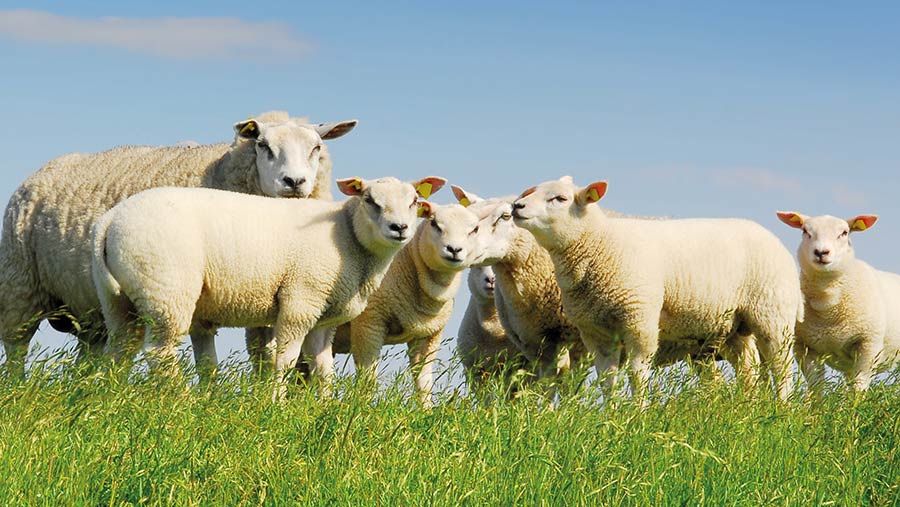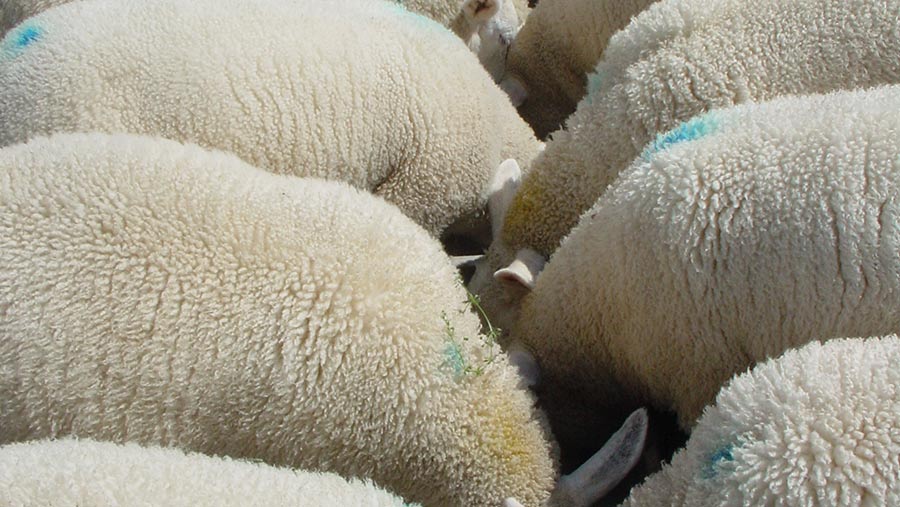Autumn store lamb glut mooted as creep cost limits finish
 © Adobe Stock
© Adobe Stock A 40-50% lift in lamb feed prices has led to under-finished lambs at markets and brought tentative predictions of an autumn store lamb glut.
Lamb feed at about £360-£390/t – with further price increases expected – has been met with a variety of strategies, including feeding less, feeding none and carrying on as normal, say auctioneers.
Some in the trade are surprised that lambs have not been weaned early and fed harder, and that ewes have not been sold early, given high costs, record cull ewe trade and rising lamb prices.
See also: EBV proven rams can add £6 a lamb, project shows
Some marts have reported lamb volumes to be two weeks behind, and AHDB data show live throughputs 22% and 33% back on the year for the past two weeks, respectively.
With supply limited, deadweight prices have been pulled upwards by a rising live ring and are touching £7/kg for some specifications.
An 18p/kg lift on the national new season lamb SQQ made a 42kg lamb about £7.56 dearer last week than in the middle of May.
Hopes are that an early Muslim festival (9 July) maintains lamb trade through June (see box), which some expect to be an incentive for farms to draw hard.
What is Eid al-Adha?

© Anthea Kitching
Eid al-Adha is one of two Islamic Eid festivals and moves each year with the lunar calendar
This year it is Saturday 9 July and will last three days
The festival elevates meat demand and often helps support national lamb prices
Sourcing typically starts at least two to three weeks before the festival
Source: Islamic Relief/AHDB
Conditions not helping
Changeable weather, with showers and some north-easterly winds, slowed lamb growth rates in the Midlands at times this spring, said Alastair Brown of Bletsoes.
He said the small window in which buyers swapped between hoggs and spring lambs to meet orders was largely over and he was hopeful of another two to three weeks of higher prices.
“People who have fed and got lambs sappy are happy with their trade, but it’s cost a serious amount of money in feed,” said Mr Brown.
He said that national trade lifted from 325p/kg to 341p/kg through late May and into June the trade went up, but some of the quality of lambs dropped.
“If you have something that’s 40kg, there is an argument that it probably wants selling whether it’s finished or not, because of costs. But then the abattoirs realise the lambs aren’t killing out well and can use it as an excuse to drag the prices back.”
A 40-50% lift in lamb feed prices has led to under-finished lambs at markets and brought tentative predictions of an autumn store lamb glut.
Lamb feed at about £360-£390/t – with further price increases expected – have been met with a variety of strategies, including feeding less, feeding none and carrying on as normal, say auctioneers.
Some in the trade are surprised that lambs have not been weaned early and fed harder, and that ewes have not been sold early, given high costs, record cull ewe trade and rising lamb prices.
Some marts have reported lamb volumes to be two weeks behind, and AHDB data show live throughputs 22% and 33% back on the year for the past two weeks, respectively.
With supply limited, deadweight prices have been pulled upwards by a rising live ring and are touching £7/kg for some specifications.
An 18p/kg lift on the national new season lamb SQQ made a 42kg lamb about £7.56 dearer last week than in the middle of May.
Hopes are that an early Muslim festival (9 July) maintains lamb trade through June (see box), which some expect to be an incentive for farms to draw hard.
Conditions not helping
Changeable weather with showers and some north-easterly winds slowed lamb growth rates down in the Midlands at times this spring, said Alastair Brown of Bletsoes.
He said the little window in which buyers swapped between hoggs and spring lambs to meet orders was largely over and he was hopeful of another two to three weeks of dear prices.
“People who have fed and got lambs sappy are happy with their trade, but it’s cost a serious amount of money in feed,” said Mr Brown.
He said that the national trade lifted from 325p/kg to 341p/kg through late May and into June. But as the trade went up, the quality of the lambs dropped a touch.
“If you have something that’s 40kg, there is an argument that it probably wants selling whether it’s finished or not because of costs. But then the abattoirs realise the lambs aren’t killing out well and can use it as an excuse to drag the prices back.”
Ludlow
Michael Thomas of McCartneys said the better export-type lambs made 350-380p/kg at Ludlow on Monday (6 June) as numbers lifted on the week to leave an SQQ of 336p/kg.
This was a drop of 14p/kg on the week for about 600 more lambs (+55%) sold overall.
“I would recommend that lambs be finished, and that vendors don’t just draw by weight,” said Mr Thomas. “Some 38kg lambs can be sappy and ready to come, while others at 42kg are still just post and rails.”
He added that costs were a major factor this year, but that while some vendors were expecting the seasonal lamb price drop in June, others were hopeful that the Muslim festival would maintain trade.
“Ewe trade is very good and there remains good demand for sheep meat. It’s very difficult to predict things weeks to week now, never mind longer term.”
Confidence despite challenges
Trade for ewes with lambs at foot was £10-£15 a life dearer than expected this spring after a disappointing start, said David Fearon, sheep breeding auctioneer for Harrison and Hetherington.
Mr Fearon pointed to cull ewe prices and feed costs as two key factors that could drive sheep farming decisions this year.
“There is very often no difference in value between a shearling with lambs and a full mouth ewe, which shows the impact of a strong cull ewe price. Some people would rather buy old sheep, wean early and get the cull price,” he said.
“Then those lambs might just be on grass and sold as stores due to the price of creep. If more stores are sold in the back end, it will hold the fat price through the summer but pressure the autumn store price.”
Ross
A 20-30p/kg gap between lean and finished lambs had been seen at Ross-on-Wye recently, said Will Probert of RG and RB Williams.
Mr Probert said this could equate to £8 a head, so, depending on feed conversion rates and feed cost, there was scope to make feeding cost-effective.
“We priced creep feeding the lambs we have at home – which are January-born – from day one, and it came to £25 a lamb if feed was £400/t,” he said.
The numbers
£120
Average price of a cull ewe sold in the UK last week (4 June), £17 up on the year
-47%
How far back lamb throughputs are on the year on the deadweight SQQ sample, at 20,503-head (AHDB)
337
The SQQ (p/kg) at Ashford on Tuesday (7 June). Throughput lifted 20.5%, but trade lifted 2-3p/kg for 1,371-head
